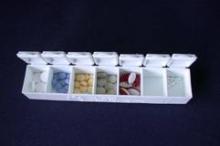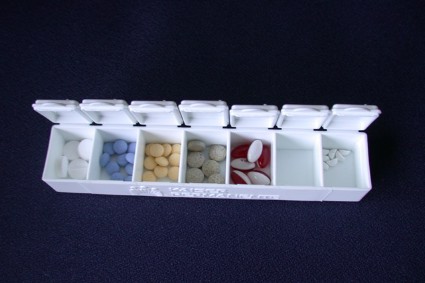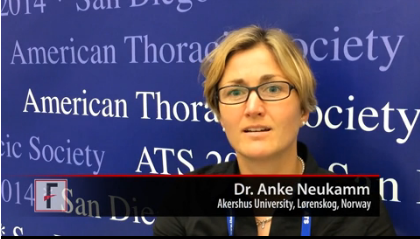User login
VIDEO: How to tell which apnea patients oxygen will help
SAN DIEGO – Some obstructive sleep apnea patients who can’t or won’t use continuous positive airway pressure therapy will benefit from supplemental oxygen therapy, but some won’t – and until now, prolonged testing is needed to tell which patients are which.
Scott A. Sands, Ph.D., and his associates at Brigham and Women’s Hospital, Boston, have found a simpler way to detect which patients would be helped by supplemental oxygen therapy. In a video interview, he describes in simple terms the patient characteristics that he looks for in polysomnography patterns he said at an international conference of the American Thoracic Society. His randomized, controlled trial in 19 patients showed that patients identified by this method did benefit from supplemental oxygen therapy, and their sleep patterns improved.
Dr. Sands reported having no financial disclosures.
The video associated with this article is no longer available on this site. Please view all of our videos on the MDedge YouTube channel
On Twitter @sherryboschert
SAN DIEGO – Some obstructive sleep apnea patients who can’t or won’t use continuous positive airway pressure therapy will benefit from supplemental oxygen therapy, but some won’t – and until now, prolonged testing is needed to tell which patients are which.
Scott A. Sands, Ph.D., and his associates at Brigham and Women’s Hospital, Boston, have found a simpler way to detect which patients would be helped by supplemental oxygen therapy. In a video interview, he describes in simple terms the patient characteristics that he looks for in polysomnography patterns he said at an international conference of the American Thoracic Society. His randomized, controlled trial in 19 patients showed that patients identified by this method did benefit from supplemental oxygen therapy, and their sleep patterns improved.
Dr. Sands reported having no financial disclosures.
The video associated with this article is no longer available on this site. Please view all of our videos on the MDedge YouTube channel
On Twitter @sherryboschert
SAN DIEGO – Some obstructive sleep apnea patients who can’t or won’t use continuous positive airway pressure therapy will benefit from supplemental oxygen therapy, but some won’t – and until now, prolonged testing is needed to tell which patients are which.
Scott A. Sands, Ph.D., and his associates at Brigham and Women’s Hospital, Boston, have found a simpler way to detect which patients would be helped by supplemental oxygen therapy. In a video interview, he describes in simple terms the patient characteristics that he looks for in polysomnography patterns he said at an international conference of the American Thoracic Society. His randomized, controlled trial in 19 patients showed that patients identified by this method did benefit from supplemental oxygen therapy, and their sleep patterns improved.
Dr. Sands reported having no financial disclosures.
The video associated with this article is no longer available on this site. Please view all of our videos on the MDedge YouTube channel
On Twitter @sherryboschert
AT ATS 2014
Statin helped endothelial function in COPD subgroup
SAN DIEGO – Twelve weeks of rosuvastatin therapy was associated with reduced systemic inflammation, but no improvement in pulmonary function in a randomized, placebo-controlled trial in 99 patients with stable chronic obstructive pulmonary disease.
However, a prespecified analysis of patients with elevated results on high-sensitivity C-reactive protein tests (hsCRP) found that those with levels higher than the median of 1.7 mg/dL at baseline showed improved endothelial function with the statin, compared with placebo, Dr. Anke Neukamm reported at an international conference of the American Thoracic Society.
The findings provided a small ray of positivity for the anti-inflammatory effects of statins in chronic obstructive pulmonary disease (COPD) on a day when two larger randomized, controlled studies reported that rosuvastatin did not reduce mortality in patients with sepsis-associated acute respiratory distress syndrome and simvastatin did not reduce exacerbations in patients with moderate to severe COPD.
Dr. Neukamm’s RODEO study (Effect of Rosuvastatin Treatment in Patients With Stable Chronic Obstructive Pulmonary Disease) randomized patients with stable chronic COPD to once-daily rosuvastatin 10 mg or placebo for 12 weeks. The groups did not differ significantly in the primary endpoint – peripheral vasodilator function expressed as a reactive hyperemia ratio.
In the subgroup analysis of patients with elevated hsCRP levels, however, the reactive hyperemia index improved from about 2.5 at baseline to 2.8 after 12 weeks of rosuvastatin and worsened from 2.6 to 2.5 in the placebo group, leaving a significant difference between groups at the end of treatment, said Dr. Neukamm of Akershus University Hospital, Lørenskog, Norway.
This suggested "a clear improvement of endothelial function in the statin group," she said.
Some physicians in the audience disputed the results, noting that rosuvastatin’s effects would not have reached statistical significance if endothelial function had not worsened in the placebo group.
Dr. Neukamm remained cautiously optimistic. Targeting statin therapy for patients with COPD to those with increased systemic inflammation as indicated by high hsCRP levels might improve vascular function, she said in an interview. Patients in the study were "a very select group with a lower cardiovascular risk" than patients in other COPD studies. Without larger prospective trials, "we don’t know if this small improvement in endothelial function would translate" into better clinical outcomes, she said.
Among secondary endpoints, circulating hsCRP levels fell from 1.4 mg/L at baseline to 1.2 mg/L in the rosuvastatin group, versus a change from 1.8 mg/L to 2.2 mg/L in the placebo group. The difference between groups was significant. Levels of the inflammatory marker interleukin-6 were stable at 4.1 pg/mL in the statin group and rose from 3.4 pg/mL to 4.4 pg/mL in the placebo group, also a significant difference between groups.
The trial excluded patients with a history of coronary artery disease, other diagnosed lung disease (except asthma), uncontrolled arterial hypertension, or diabetes, as well as patients who had used statins in the prior 4 weeks or who had a clear indication for statin use.
Thirty-three adverse events included COPD acute exacerbations, constipation, diarrhea, nausea, myalgia, and vertigo. Seven serious adverse events included hospitalizations for COPD exacerbations, as well as atrial flutter in one patient.
Patients had a mean age of 65 years, 48% were female, and 25% had a history of hypertension. They had a smoking history of a mean 37 pack-years. Baseline patient characteristics were similar between groups except for a higher percentage of current smokers in the placebo group (49%), compared with the rosuvastatin group (26%).
Stable COPD and acute exacerbations have been associated with systemic inflammation as reflected in increased levels of CRP and other inflammatory markers. Cardiovascular disease is a major comorbidity in patients with COPD, and inflammation is a hallmark of the atherosclerotic process, Dr. Neukamm said. Endothelial dysfunction, which is an early predictor of atherosclerosis, has been shown to be increased in patients with COPD.
Dr. Jennifer Cox, FCCP, comments: COPD is known to be a systemic illness characterized by inflammation. Looking at potential therapies for COPD that target the underlying inflammation seems intuitive. However, in this study looking at rosuvastatin and endothelial function, there was no significant change in pulmonary function after 12 weeks of therapy. In a prespecified group of patients with elevated levels of high-sensitivity C-reactive protein (hsCRP), they had a statistically significant decrease in inflammatory markers and improved endothelial function. It remains to be seen if this will translate into clinically significant improvements in morbidity, mortality, and quality of life in those that suffer from COPD. Given the significant side effect profile of statins, more studies are needed before prescribing to those patients with COPD without other indications for statin therapy.
Dr. Jennifer Cox, FCCP, comments: COPD is known to be a systemic illness characterized by inflammation. Looking at potential therapies for COPD that target the underlying inflammation seems intuitive. However, in this study looking at rosuvastatin and endothelial function, there was no significant change in pulmonary function after 12 weeks of therapy. In a prespecified group of patients with elevated levels of high-sensitivity C-reactive protein (hsCRP), they had a statistically significant decrease in inflammatory markers and improved endothelial function. It remains to be seen if this will translate into clinically significant improvements in morbidity, mortality, and quality of life in those that suffer from COPD. Given the significant side effect profile of statins, more studies are needed before prescribing to those patients with COPD without other indications for statin therapy.
Dr. Jennifer Cox, FCCP, comments: COPD is known to be a systemic illness characterized by inflammation. Looking at potential therapies for COPD that target the underlying inflammation seems intuitive. However, in this study looking at rosuvastatin and endothelial function, there was no significant change in pulmonary function after 12 weeks of therapy. In a prespecified group of patients with elevated levels of high-sensitivity C-reactive protein (hsCRP), they had a statistically significant decrease in inflammatory markers and improved endothelial function. It remains to be seen if this will translate into clinically significant improvements in morbidity, mortality, and quality of life in those that suffer from COPD. Given the significant side effect profile of statins, more studies are needed before prescribing to those patients with COPD without other indications for statin therapy.
SAN DIEGO – Twelve weeks of rosuvastatin therapy was associated with reduced systemic inflammation, but no improvement in pulmonary function in a randomized, placebo-controlled trial in 99 patients with stable chronic obstructive pulmonary disease.
However, a prespecified analysis of patients with elevated results on high-sensitivity C-reactive protein tests (hsCRP) found that those with levels higher than the median of 1.7 mg/dL at baseline showed improved endothelial function with the statin, compared with placebo, Dr. Anke Neukamm reported at an international conference of the American Thoracic Society.
The findings provided a small ray of positivity for the anti-inflammatory effects of statins in chronic obstructive pulmonary disease (COPD) on a day when two larger randomized, controlled studies reported that rosuvastatin did not reduce mortality in patients with sepsis-associated acute respiratory distress syndrome and simvastatin did not reduce exacerbations in patients with moderate to severe COPD.
Dr. Neukamm’s RODEO study (Effect of Rosuvastatin Treatment in Patients With Stable Chronic Obstructive Pulmonary Disease) randomized patients with stable chronic COPD to once-daily rosuvastatin 10 mg or placebo for 12 weeks. The groups did not differ significantly in the primary endpoint – peripheral vasodilator function expressed as a reactive hyperemia ratio.
In the subgroup analysis of patients with elevated hsCRP levels, however, the reactive hyperemia index improved from about 2.5 at baseline to 2.8 after 12 weeks of rosuvastatin and worsened from 2.6 to 2.5 in the placebo group, leaving a significant difference between groups at the end of treatment, said Dr. Neukamm of Akershus University Hospital, Lørenskog, Norway.
This suggested "a clear improvement of endothelial function in the statin group," she said.
Some physicians in the audience disputed the results, noting that rosuvastatin’s effects would not have reached statistical significance if endothelial function had not worsened in the placebo group.
Dr. Neukamm remained cautiously optimistic. Targeting statin therapy for patients with COPD to those with increased systemic inflammation as indicated by high hsCRP levels might improve vascular function, she said in an interview. Patients in the study were "a very select group with a lower cardiovascular risk" than patients in other COPD studies. Without larger prospective trials, "we don’t know if this small improvement in endothelial function would translate" into better clinical outcomes, she said.
Among secondary endpoints, circulating hsCRP levels fell from 1.4 mg/L at baseline to 1.2 mg/L in the rosuvastatin group, versus a change from 1.8 mg/L to 2.2 mg/L in the placebo group. The difference between groups was significant. Levels of the inflammatory marker interleukin-6 were stable at 4.1 pg/mL in the statin group and rose from 3.4 pg/mL to 4.4 pg/mL in the placebo group, also a significant difference between groups.
The trial excluded patients with a history of coronary artery disease, other diagnosed lung disease (except asthma), uncontrolled arterial hypertension, or diabetes, as well as patients who had used statins in the prior 4 weeks or who had a clear indication for statin use.
Thirty-three adverse events included COPD acute exacerbations, constipation, diarrhea, nausea, myalgia, and vertigo. Seven serious adverse events included hospitalizations for COPD exacerbations, as well as atrial flutter in one patient.
Patients had a mean age of 65 years, 48% were female, and 25% had a history of hypertension. They had a smoking history of a mean 37 pack-years. Baseline patient characteristics were similar between groups except for a higher percentage of current smokers in the placebo group (49%), compared with the rosuvastatin group (26%).
Stable COPD and acute exacerbations have been associated with systemic inflammation as reflected in increased levels of CRP and other inflammatory markers. Cardiovascular disease is a major comorbidity in patients with COPD, and inflammation is a hallmark of the atherosclerotic process, Dr. Neukamm said. Endothelial dysfunction, which is an early predictor of atherosclerosis, has been shown to be increased in patients with COPD.
SAN DIEGO – Twelve weeks of rosuvastatin therapy was associated with reduced systemic inflammation, but no improvement in pulmonary function in a randomized, placebo-controlled trial in 99 patients with stable chronic obstructive pulmonary disease.
However, a prespecified analysis of patients with elevated results on high-sensitivity C-reactive protein tests (hsCRP) found that those with levels higher than the median of 1.7 mg/dL at baseline showed improved endothelial function with the statin, compared with placebo, Dr. Anke Neukamm reported at an international conference of the American Thoracic Society.
The findings provided a small ray of positivity for the anti-inflammatory effects of statins in chronic obstructive pulmonary disease (COPD) on a day when two larger randomized, controlled studies reported that rosuvastatin did not reduce mortality in patients with sepsis-associated acute respiratory distress syndrome and simvastatin did not reduce exacerbations in patients with moderate to severe COPD.
Dr. Neukamm’s RODEO study (Effect of Rosuvastatin Treatment in Patients With Stable Chronic Obstructive Pulmonary Disease) randomized patients with stable chronic COPD to once-daily rosuvastatin 10 mg or placebo for 12 weeks. The groups did not differ significantly in the primary endpoint – peripheral vasodilator function expressed as a reactive hyperemia ratio.
In the subgroup analysis of patients with elevated hsCRP levels, however, the reactive hyperemia index improved from about 2.5 at baseline to 2.8 after 12 weeks of rosuvastatin and worsened from 2.6 to 2.5 in the placebo group, leaving a significant difference between groups at the end of treatment, said Dr. Neukamm of Akershus University Hospital, Lørenskog, Norway.
This suggested "a clear improvement of endothelial function in the statin group," she said.
Some physicians in the audience disputed the results, noting that rosuvastatin’s effects would not have reached statistical significance if endothelial function had not worsened in the placebo group.
Dr. Neukamm remained cautiously optimistic. Targeting statin therapy for patients with COPD to those with increased systemic inflammation as indicated by high hsCRP levels might improve vascular function, she said in an interview. Patients in the study were "a very select group with a lower cardiovascular risk" than patients in other COPD studies. Without larger prospective trials, "we don’t know if this small improvement in endothelial function would translate" into better clinical outcomes, she said.
Among secondary endpoints, circulating hsCRP levels fell from 1.4 mg/L at baseline to 1.2 mg/L in the rosuvastatin group, versus a change from 1.8 mg/L to 2.2 mg/L in the placebo group. The difference between groups was significant. Levels of the inflammatory marker interleukin-6 were stable at 4.1 pg/mL in the statin group and rose from 3.4 pg/mL to 4.4 pg/mL in the placebo group, also a significant difference between groups.
The trial excluded patients with a history of coronary artery disease, other diagnosed lung disease (except asthma), uncontrolled arterial hypertension, or diabetes, as well as patients who had used statins in the prior 4 weeks or who had a clear indication for statin use.
Thirty-three adverse events included COPD acute exacerbations, constipation, diarrhea, nausea, myalgia, and vertigo. Seven serious adverse events included hospitalizations for COPD exacerbations, as well as atrial flutter in one patient.
Patients had a mean age of 65 years, 48% were female, and 25% had a history of hypertension. They had a smoking history of a mean 37 pack-years. Baseline patient characteristics were similar between groups except for a higher percentage of current smokers in the placebo group (49%), compared with the rosuvastatin group (26%).
Stable COPD and acute exacerbations have been associated with systemic inflammation as reflected in increased levels of CRP and other inflammatory markers. Cardiovascular disease is a major comorbidity in patients with COPD, and inflammation is a hallmark of the atherosclerotic process, Dr. Neukamm said. Endothelial dysfunction, which is an early predictor of atherosclerosis, has been shown to be increased in patients with COPD.
Key clinical point: Focusing statin therapy for COPD patients on those with increased systemic inflammation as indicated by elevated hsCRP might improve vascular function, but larger studies are needed.
Major finding: Rosuvastatin failed to improve pulmonary function overall, but significantly improved peripheral vasodilator function in patients with elevated hsCRP levels at baseline, indicated by a final reactive hyperemia index of 2.8 vs. 2.5 with placebo.
Data source: A randomized, controlled trial of 10 mg of rosuvastatin or placebo for 12 weeks in 99 patients with stable COPD.
Disclosures: The study was funded by the Norwegian Extra Foundation for Health and Rehabilitation and by AstraZeneca, which makes a brand name formulation of rosuvastatin. Dr. Neukamm has been a speaker for AstraZeneca.
Corticosteroid doses cut with novel inhalation system
SAN DIEGO – Adults on chronic oral corticosteroids for asthma were able to decrease their doses while maintaining lung function by adding 0.5-1 mg budesonide delivered by an experimental inhaler in a randomized study of 199 patients.
The four-arm phase II/III study compared 18 weeks of twice-daily treatment using the AKITA® inhalation system or a conventional nebulizer while tapering oral corticosteroids. The compressor-driven system is designed to deliver the budesonide suspension to the small airways of the lungs. It is not approved in the United States to treat adults with asthma.
The system delivered budesonide 1 mg, budesonide 0.5 mg, or placebo, compared with an open-label treatment group that used a nebulizer to deliver 1 mg budesonide. Oral corticosteroids were tapered to week 14. Patients were followed to week 20, with lung function parameters measures every 2 weeks.
The mean forced expiratory volume at 1 second (FEV1) significantly improved in the AKITA 1-mg budesonide group, compared with baseline, Dr. Sebastian Canisius and his associates reported at an international conference of the American Thoracic Society.
Mean FEV1 improved by 239 mL in the 1-mg AKITA group; improvements were lower in the other groups: 126 mL in the AKITA 0.5-mg budesonide group, 93 mL for placebo, and 137 mL in the nebulizer group.
Another surrogate marker of small airway function improved significantly in the AKITA 1-mg group compared with the placebo group – forced expiratory flow 25%-75% of vital capacity, or FEF (25-75), said Dr. Canisius, director of clinical development and drug safety for the Vectura Group, Kassel Area, Germany, which developed the inhalation system.
The FEF (25-75) improved by a mean of 0.2 L/s, compared with baseline in the AKITA 1-mg group, and did not change in the placebo group. Improvements in the other two groups were smaller and not significant compared with placebo.
Patients in the AKITA 1-mg group were significantly less likely to develop an asthma exacerbation, compared with the nebulizer group (8% vs. 22%) and went significantly longer before an exacerbation (96 days vs. 50 days).
Dr. Canisius works for and owns stock in the company that developed the inhalation device.
Dr. Daniel Ouellette, FCCP, comments: Physicians caring for patients with severe asthma frequently encounter patients who require oral corticosteroid therapy despite being treated with significant complex inhaled regimens. The new AKITA® inhalation system is designed to deliver an aerosol more effectively to the distal airways than traditional nebulizers or handheld inhalant devices. In a recent trial, when compared to budesonide delivered by a traditional nebulizer, use of the system was associated with improvements in spirometric measures, reduction in the number of occurrences of asthma exacerbations, and increased length of time between recurrent exacerbations. The adverse consequences of long-term oral corticosteroid use will make the AKITA system an attractive adjunct to asthma management, if it can be demonstrated that the oral corticosteroid dose can be reduced, or their use eliminated, in severe asthma patients. However, long-term studies will be necessary to determine if there is significant systemic absorption, and thus risk of attendant consequences, of corticosteroids when administered by this device. 
Dr. Daniel Ouellette
Dr. Daniel Ouellette, FCCP, comments: Physicians caring for patients with severe asthma frequently encounter patients who require oral corticosteroid therapy despite being treated with significant complex inhaled regimens. The new AKITA® inhalation system is designed to deliver an aerosol more effectively to the distal airways than traditional nebulizers or handheld inhalant devices. In a recent trial, when compared to budesonide delivered by a traditional nebulizer, use of the system was associated with improvements in spirometric measures, reduction in the number of occurrences of asthma exacerbations, and increased length of time between recurrent exacerbations. The adverse consequences of long-term oral corticosteroid use will make the AKITA system an attractive adjunct to asthma management, if it can be demonstrated that the oral corticosteroid dose can be reduced, or their use eliminated, in severe asthma patients. However, long-term studies will be necessary to determine if there is significant systemic absorption, and thus risk of attendant consequences, of corticosteroids when administered by this device. 
Dr. Daniel Ouellette
Dr. Daniel Ouellette, FCCP, comments: Physicians caring for patients with severe asthma frequently encounter patients who require oral corticosteroid therapy despite being treated with significant complex inhaled regimens. The new AKITA® inhalation system is designed to deliver an aerosol more effectively to the distal airways than traditional nebulizers or handheld inhalant devices. In a recent trial, when compared to budesonide delivered by a traditional nebulizer, use of the system was associated with improvements in spirometric measures, reduction in the number of occurrences of asthma exacerbations, and increased length of time between recurrent exacerbations. The adverse consequences of long-term oral corticosteroid use will make the AKITA system an attractive adjunct to asthma management, if it can be demonstrated that the oral corticosteroid dose can be reduced, or their use eliminated, in severe asthma patients. However, long-term studies will be necessary to determine if there is significant systemic absorption, and thus risk of attendant consequences, of corticosteroids when administered by this device. 
Dr. Daniel Ouellette
SAN DIEGO – Adults on chronic oral corticosteroids for asthma were able to decrease their doses while maintaining lung function by adding 0.5-1 mg budesonide delivered by an experimental inhaler in a randomized study of 199 patients.
The four-arm phase II/III study compared 18 weeks of twice-daily treatment using the AKITA® inhalation system or a conventional nebulizer while tapering oral corticosteroids. The compressor-driven system is designed to deliver the budesonide suspension to the small airways of the lungs. It is not approved in the United States to treat adults with asthma.
The system delivered budesonide 1 mg, budesonide 0.5 mg, or placebo, compared with an open-label treatment group that used a nebulizer to deliver 1 mg budesonide. Oral corticosteroids were tapered to week 14. Patients were followed to week 20, with lung function parameters measures every 2 weeks.
The mean forced expiratory volume at 1 second (FEV1) significantly improved in the AKITA 1-mg budesonide group, compared with baseline, Dr. Sebastian Canisius and his associates reported at an international conference of the American Thoracic Society.
Mean FEV1 improved by 239 mL in the 1-mg AKITA group; improvements were lower in the other groups: 126 mL in the AKITA 0.5-mg budesonide group, 93 mL for placebo, and 137 mL in the nebulizer group.
Another surrogate marker of small airway function improved significantly in the AKITA 1-mg group compared with the placebo group – forced expiratory flow 25%-75% of vital capacity, or FEF (25-75), said Dr. Canisius, director of clinical development and drug safety for the Vectura Group, Kassel Area, Germany, which developed the inhalation system.
The FEF (25-75) improved by a mean of 0.2 L/s, compared with baseline in the AKITA 1-mg group, and did not change in the placebo group. Improvements in the other two groups were smaller and not significant compared with placebo.
Patients in the AKITA 1-mg group were significantly less likely to develop an asthma exacerbation, compared with the nebulizer group (8% vs. 22%) and went significantly longer before an exacerbation (96 days vs. 50 days).
Dr. Canisius works for and owns stock in the company that developed the inhalation device.
SAN DIEGO – Adults on chronic oral corticosteroids for asthma were able to decrease their doses while maintaining lung function by adding 0.5-1 mg budesonide delivered by an experimental inhaler in a randomized study of 199 patients.
The four-arm phase II/III study compared 18 weeks of twice-daily treatment using the AKITA® inhalation system or a conventional nebulizer while tapering oral corticosteroids. The compressor-driven system is designed to deliver the budesonide suspension to the small airways of the lungs. It is not approved in the United States to treat adults with asthma.
The system delivered budesonide 1 mg, budesonide 0.5 mg, or placebo, compared with an open-label treatment group that used a nebulizer to deliver 1 mg budesonide. Oral corticosteroids were tapered to week 14. Patients were followed to week 20, with lung function parameters measures every 2 weeks.
The mean forced expiratory volume at 1 second (FEV1) significantly improved in the AKITA 1-mg budesonide group, compared with baseline, Dr. Sebastian Canisius and his associates reported at an international conference of the American Thoracic Society.
Mean FEV1 improved by 239 mL in the 1-mg AKITA group; improvements were lower in the other groups: 126 mL in the AKITA 0.5-mg budesonide group, 93 mL for placebo, and 137 mL in the nebulizer group.
Another surrogate marker of small airway function improved significantly in the AKITA 1-mg group compared with the placebo group – forced expiratory flow 25%-75% of vital capacity, or FEF (25-75), said Dr. Canisius, director of clinical development and drug safety for the Vectura Group, Kassel Area, Germany, which developed the inhalation system.
The FEF (25-75) improved by a mean of 0.2 L/s, compared with baseline in the AKITA 1-mg group, and did not change in the placebo group. Improvements in the other two groups were smaller and not significant compared with placebo.
Patients in the AKITA 1-mg group were significantly less likely to develop an asthma exacerbation, compared with the nebulizer group (8% vs. 22%) and went significantly longer before an exacerbation (96 days vs. 50 days).
Dr. Canisius works for and owns stock in the company that developed the inhalation device.
Key clinical point: A novel inhaler that targets small airways can improve budesonide delivery.
Major finding: The mean FEV1 improved significantly in the AKITA 1-mg budesonide group (by 239 mL) compared with baseline.
Data source: A randomized, four-arm, parallel-group, placebo-controlled trial comparing budesonide delivery methods in 199 patients.
Disclosures: The study presenter is an employee of and investor in the company that developed the inhalation device.
Statins don’t help, may harm in COPD, ARDS
SAN DIEGO – Two separate prospective, multicenter trials of statins stopped early when interim results showed they did not help – and potentially harmed – patients with moderate to severe chronic obstructive pulmonary disease or sepsis-associated acute respiratory distress syndrome.
The findings contradict previous observational data suggesting that the potential anti-inflammatory effects of statins (3-hydroxy-3-methylglutaryl coenzyme A reductase inhibitors [HMG-CoA]) might benefit patients with these two diseases.
Statins did not significantly reduce rates of exacerbation of chronic obstructive pulmonary disease (COPD) or the time to first exacerbation in a study of 885 patients with moderate to severe COPD who were at high risk for exacerbations and who did not require statins for other indications. Patients in the STATCOPE study (Prospective Randomized Placebo-Controlled Trial of Simvastatin in the Prevention of COPD) received a daily oral dose of either 40 mg simvastatin or placebo for 12-36 months.
The simvastatin group had a mean of 1.36 exacerbations/person-year, compared with 1.39/person-year in the placebo group. The median number of days to the first exacerbation was 223 on simvastatin and 231 on placebo, differences that were not significant, Dr. Gerard J. Criner and his associates reported at an international conference of the American Thoracic Society.
The results were published online by the New England Journal of Medicine (2014 May 18 [doi:10.1056/NEJMoa1403086]).
Among the 885 patients for whom follow-up information was available, 1,982 acute COPD exacerbations occurred, 965 in 430 patients on simvastatin and 1,017 exacerbations in 447 patients on placebo, said Dr. Criner, professor of medicine and director of the medical intensive care unit and the ventilator rehabilitation unit at Temple University, Philadelphia.
Overall, 34% of patients had three or more exacerbations of COPD, with similar numbers in each group – 141 in the simvastatin group and 155 in the placebo groups. The proportions of patients who received glucocorticoid therapy or antibiotics for exacerbations did not differ significantly between groups.
The simvastatin group had a significantly higher rate of nonfatal serious adverse events involving the GI tract (mainly nausea and bloating from simvastatin) in 30 patients (0.05 events/person-year), compared with events in 17 patients on placebo (0.02 events/person-year). Rates of other nonfatal adverse events were similar between groups, with pneumonia and other respiratory and cardiovascular events most common. Twenty-eight patients on simvastatin and 30 on placebo died.
Asked why he thinks the STATCOPE study’s negative results didn’t confirm previous positive findings from observational studies including thousands of patients, Dr. Criner speculated that excluding patients with indications for statins may have removed patients with cardiovascular risks who were included in other studies. "I think a lot of the problems we’re seeing for exacerbations in COPD might be related to cardiovascular events in patients who aren’t appropriately treated with statins, who should be," he said.
Rosuvastatin sags in SAILS trial
In the separate double-blind SAILS trial (Statins for Acutely Injured Lungs [ARDS] From Sepsis), enteral rosuvastatin did not decrease mortality, compared with placebo, in 745 patients with sepsis-associated acute respiratory distress syndrome (ARDS). Dr. Jonathon D. Truwit, FCCP, and his associates reported their findings, which were discussed at the ATS meeting, in the New England Journal of Medicine (2014 May 18 [doi:10.1056/NEJMoa1401520]).
Researchers found that 28.5% of patients on rosuvastatin and 25% on placebo died before hospital discharge or within 60 days if the patient was still in a health care facility, reported Dr. Truwit, professor of medicine at the Medical College of Wisconsin, Madison.
Patients in the rosuvastatin group received a loading dose of 40 mg followed by daily maintenance doses of 20 mg (or 10 mg for patients with a morning serum creatinine level of 2.8 mg/dL or more who were not receiving renal replacement therapy. Treatment continued until the third day of discharge from the ICU, hospital discharge, or death, whichever came first.
Both the rosuvastatin and placebo groups had a mean of 15 ventilator-free days.
Results also did not differ significantly between groups for the 339 patients who were in shock at the start of the study or for 109 patients who had used statins before the study and who underwent a 48-hour washout period before randomization.
Patients on rosuvastatin had a mean of 10.1 days free of renal failure and 10.8 days free of hepatic failure within the first 14 days, both significantly fewer compared with patients on placebo (11 and 11.8 days, respectively). "These differences in organ-failure-free days were small, and their significance may be spurious owing to the number of secondary endpoints analyzed. However, we cannot rule out a detrimental effect of rosuvastatin," the investigators wrote.
The results, combined with previous smaller randomized trials of other statins, suggest no benefits from starting or continuing statin therapy for sepsis-associated ARDS, Dr. Truwit said.
"The finding in observational studies that previous statin use provides a benefit may reflect better access to health care among patients who use statins than among those who do not, with a shorter time to the initiation of antibiotic therapy at the onset of symptoms of infection in statin users," according to the journal article.
The National Heart, Lung, and Blood Institute and the Canadian Institutes of Health Research funded the STATCOPE trial. The investigators reported financial associations with dozens of companies, including five of Dr. Criner’s coinvestigators who had financial associations with Merck, which makes simvastatin. The SAILS trial was sponsored by the NHLBI and by AstraZeneca, which makes rosuvastatin. Dr. Truwit reported having no financial disclosures. Several of his coinvestigators reported financial ties to AstraZeneca and other companies.
On Twitter @sherryboschert
Dr. Eric Gartman, FCCP, comments: The results of these two studies represent two poignant examples of the importance of rigorous trial design and patience prior to changing clinical practice. As has been the case with many interventions in pulmonary and critical care medicine, the conclusions of observational studies were not replicated or contradicted when subjected to more structured study design. The data from these two studies should elicit a thoughtful pause in those who have been overheard stating, "We should just put statins in the water."
Dr. Eric Gartman, FCCP, comments: The results of these two studies represent two poignant examples of the importance of rigorous trial design and patience prior to changing clinical practice. As has been the case with many interventions in pulmonary and critical care medicine, the conclusions of observational studies were not replicated or contradicted when subjected to more structured study design. The data from these two studies should elicit a thoughtful pause in those who have been overheard stating, "We should just put statins in the water."
Dr. Eric Gartman, FCCP, comments: The results of these two studies represent two poignant examples of the importance of rigorous trial design and patience prior to changing clinical practice. As has been the case with many interventions in pulmonary and critical care medicine, the conclusions of observational studies were not replicated or contradicted when subjected to more structured study design. The data from these two studies should elicit a thoughtful pause in those who have been overheard stating, "We should just put statins in the water."
SAN DIEGO – Two separate prospective, multicenter trials of statins stopped early when interim results showed they did not help – and potentially harmed – patients with moderate to severe chronic obstructive pulmonary disease or sepsis-associated acute respiratory distress syndrome.
The findings contradict previous observational data suggesting that the potential anti-inflammatory effects of statins (3-hydroxy-3-methylglutaryl coenzyme A reductase inhibitors [HMG-CoA]) might benefit patients with these two diseases.
Statins did not significantly reduce rates of exacerbation of chronic obstructive pulmonary disease (COPD) or the time to first exacerbation in a study of 885 patients with moderate to severe COPD who were at high risk for exacerbations and who did not require statins for other indications. Patients in the STATCOPE study (Prospective Randomized Placebo-Controlled Trial of Simvastatin in the Prevention of COPD) received a daily oral dose of either 40 mg simvastatin or placebo for 12-36 months.
The simvastatin group had a mean of 1.36 exacerbations/person-year, compared with 1.39/person-year in the placebo group. The median number of days to the first exacerbation was 223 on simvastatin and 231 on placebo, differences that were not significant, Dr. Gerard J. Criner and his associates reported at an international conference of the American Thoracic Society.
The results were published online by the New England Journal of Medicine (2014 May 18 [doi:10.1056/NEJMoa1403086]).
Among the 885 patients for whom follow-up information was available, 1,982 acute COPD exacerbations occurred, 965 in 430 patients on simvastatin and 1,017 exacerbations in 447 patients on placebo, said Dr. Criner, professor of medicine and director of the medical intensive care unit and the ventilator rehabilitation unit at Temple University, Philadelphia.
Overall, 34% of patients had three or more exacerbations of COPD, with similar numbers in each group – 141 in the simvastatin group and 155 in the placebo groups. The proportions of patients who received glucocorticoid therapy or antibiotics for exacerbations did not differ significantly between groups.
The simvastatin group had a significantly higher rate of nonfatal serious adverse events involving the GI tract (mainly nausea and bloating from simvastatin) in 30 patients (0.05 events/person-year), compared with events in 17 patients on placebo (0.02 events/person-year). Rates of other nonfatal adverse events were similar between groups, with pneumonia and other respiratory and cardiovascular events most common. Twenty-eight patients on simvastatin and 30 on placebo died.
Asked why he thinks the STATCOPE study’s negative results didn’t confirm previous positive findings from observational studies including thousands of patients, Dr. Criner speculated that excluding patients with indications for statins may have removed patients with cardiovascular risks who were included in other studies. "I think a lot of the problems we’re seeing for exacerbations in COPD might be related to cardiovascular events in patients who aren’t appropriately treated with statins, who should be," he said.
Rosuvastatin sags in SAILS trial
In the separate double-blind SAILS trial (Statins for Acutely Injured Lungs [ARDS] From Sepsis), enteral rosuvastatin did not decrease mortality, compared with placebo, in 745 patients with sepsis-associated acute respiratory distress syndrome (ARDS). Dr. Jonathon D. Truwit, FCCP, and his associates reported their findings, which were discussed at the ATS meeting, in the New England Journal of Medicine (2014 May 18 [doi:10.1056/NEJMoa1401520]).
Researchers found that 28.5% of patients on rosuvastatin and 25% on placebo died before hospital discharge or within 60 days if the patient was still in a health care facility, reported Dr. Truwit, professor of medicine at the Medical College of Wisconsin, Madison.
Patients in the rosuvastatin group received a loading dose of 40 mg followed by daily maintenance doses of 20 mg (or 10 mg for patients with a morning serum creatinine level of 2.8 mg/dL or more who were not receiving renal replacement therapy. Treatment continued until the third day of discharge from the ICU, hospital discharge, or death, whichever came first.
Both the rosuvastatin and placebo groups had a mean of 15 ventilator-free days.
Results also did not differ significantly between groups for the 339 patients who were in shock at the start of the study or for 109 patients who had used statins before the study and who underwent a 48-hour washout period before randomization.
Patients on rosuvastatin had a mean of 10.1 days free of renal failure and 10.8 days free of hepatic failure within the first 14 days, both significantly fewer compared with patients on placebo (11 and 11.8 days, respectively). "These differences in organ-failure-free days were small, and their significance may be spurious owing to the number of secondary endpoints analyzed. However, we cannot rule out a detrimental effect of rosuvastatin," the investigators wrote.
The results, combined with previous smaller randomized trials of other statins, suggest no benefits from starting or continuing statin therapy for sepsis-associated ARDS, Dr. Truwit said.
"The finding in observational studies that previous statin use provides a benefit may reflect better access to health care among patients who use statins than among those who do not, with a shorter time to the initiation of antibiotic therapy at the onset of symptoms of infection in statin users," according to the journal article.
The National Heart, Lung, and Blood Institute and the Canadian Institutes of Health Research funded the STATCOPE trial. The investigators reported financial associations with dozens of companies, including five of Dr. Criner’s coinvestigators who had financial associations with Merck, which makes simvastatin. The SAILS trial was sponsored by the NHLBI and by AstraZeneca, which makes rosuvastatin. Dr. Truwit reported having no financial disclosures. Several of his coinvestigators reported financial ties to AstraZeneca and other companies.
On Twitter @sherryboschert
SAN DIEGO – Two separate prospective, multicenter trials of statins stopped early when interim results showed they did not help – and potentially harmed – patients with moderate to severe chronic obstructive pulmonary disease or sepsis-associated acute respiratory distress syndrome.
The findings contradict previous observational data suggesting that the potential anti-inflammatory effects of statins (3-hydroxy-3-methylglutaryl coenzyme A reductase inhibitors [HMG-CoA]) might benefit patients with these two diseases.
Statins did not significantly reduce rates of exacerbation of chronic obstructive pulmonary disease (COPD) or the time to first exacerbation in a study of 885 patients with moderate to severe COPD who were at high risk for exacerbations and who did not require statins for other indications. Patients in the STATCOPE study (Prospective Randomized Placebo-Controlled Trial of Simvastatin in the Prevention of COPD) received a daily oral dose of either 40 mg simvastatin or placebo for 12-36 months.
The simvastatin group had a mean of 1.36 exacerbations/person-year, compared with 1.39/person-year in the placebo group. The median number of days to the first exacerbation was 223 on simvastatin and 231 on placebo, differences that were not significant, Dr. Gerard J. Criner and his associates reported at an international conference of the American Thoracic Society.
The results were published online by the New England Journal of Medicine (2014 May 18 [doi:10.1056/NEJMoa1403086]).
Among the 885 patients for whom follow-up information was available, 1,982 acute COPD exacerbations occurred, 965 in 430 patients on simvastatin and 1,017 exacerbations in 447 patients on placebo, said Dr. Criner, professor of medicine and director of the medical intensive care unit and the ventilator rehabilitation unit at Temple University, Philadelphia.
Overall, 34% of patients had three or more exacerbations of COPD, with similar numbers in each group – 141 in the simvastatin group and 155 in the placebo groups. The proportions of patients who received glucocorticoid therapy or antibiotics for exacerbations did not differ significantly between groups.
The simvastatin group had a significantly higher rate of nonfatal serious adverse events involving the GI tract (mainly nausea and bloating from simvastatin) in 30 patients (0.05 events/person-year), compared with events in 17 patients on placebo (0.02 events/person-year). Rates of other nonfatal adverse events were similar between groups, with pneumonia and other respiratory and cardiovascular events most common. Twenty-eight patients on simvastatin and 30 on placebo died.
Asked why he thinks the STATCOPE study’s negative results didn’t confirm previous positive findings from observational studies including thousands of patients, Dr. Criner speculated that excluding patients with indications for statins may have removed patients with cardiovascular risks who were included in other studies. "I think a lot of the problems we’re seeing for exacerbations in COPD might be related to cardiovascular events in patients who aren’t appropriately treated with statins, who should be," he said.
Rosuvastatin sags in SAILS trial
In the separate double-blind SAILS trial (Statins for Acutely Injured Lungs [ARDS] From Sepsis), enteral rosuvastatin did not decrease mortality, compared with placebo, in 745 patients with sepsis-associated acute respiratory distress syndrome (ARDS). Dr. Jonathon D. Truwit, FCCP, and his associates reported their findings, which were discussed at the ATS meeting, in the New England Journal of Medicine (2014 May 18 [doi:10.1056/NEJMoa1401520]).
Researchers found that 28.5% of patients on rosuvastatin and 25% on placebo died before hospital discharge or within 60 days if the patient was still in a health care facility, reported Dr. Truwit, professor of medicine at the Medical College of Wisconsin, Madison.
Patients in the rosuvastatin group received a loading dose of 40 mg followed by daily maintenance doses of 20 mg (or 10 mg for patients with a morning serum creatinine level of 2.8 mg/dL or more who were not receiving renal replacement therapy. Treatment continued until the third day of discharge from the ICU, hospital discharge, or death, whichever came first.
Both the rosuvastatin and placebo groups had a mean of 15 ventilator-free days.
Results also did not differ significantly between groups for the 339 patients who were in shock at the start of the study or for 109 patients who had used statins before the study and who underwent a 48-hour washout period before randomization.
Patients on rosuvastatin had a mean of 10.1 days free of renal failure and 10.8 days free of hepatic failure within the first 14 days, both significantly fewer compared with patients on placebo (11 and 11.8 days, respectively). "These differences in organ-failure-free days were small, and their significance may be spurious owing to the number of secondary endpoints analyzed. However, we cannot rule out a detrimental effect of rosuvastatin," the investigators wrote.
The results, combined with previous smaller randomized trials of other statins, suggest no benefits from starting or continuing statin therapy for sepsis-associated ARDS, Dr. Truwit said.
"The finding in observational studies that previous statin use provides a benefit may reflect better access to health care among patients who use statins than among those who do not, with a shorter time to the initiation of antibiotic therapy at the onset of symptoms of infection in statin users," according to the journal article.
The National Heart, Lung, and Blood Institute and the Canadian Institutes of Health Research funded the STATCOPE trial. The investigators reported financial associations with dozens of companies, including five of Dr. Criner’s coinvestigators who had financial associations with Merck, which makes simvastatin. The SAILS trial was sponsored by the NHLBI and by AstraZeneca, which makes rosuvastatin. Dr. Truwit reported having no financial disclosures. Several of his coinvestigators reported financial ties to AstraZeneca and other companies.
On Twitter @sherryboschert
Key clinical point: Statins did not help, and possibly harmed, patients with moderate to severe COPD or sepsis-associated ARDS who did not require statins for other indications.
Major finding: The mean rate of COPD exacerbations was 1.36 in the simvastatin group and 1.39 in the placebo group, not significantly different.
Data source: STATCOPE, a multicenter prospective randomized, placebo-controlled trial of daily oral simvastatin 40 mg or placebo in 885 patients with COPD at high risk for exacerbations.
Disclosures: The National Heart, Lung, and Blood Institute and the Canadian Institutes of Health Research funded STATCOPE. Several coinvestigators reported financial associations with dozens of companies, including with Merck, which makes simvastatin.
Mesalazine didn’t help diarrhea-predominant IBS
CHICAGO – Treating diarrhea-predominant irritable bowel syndrome with mesalazine for 12 weeks failed to improve stool frequency or other symptoms, compared with placebo, in a multicenter, randomized double-blind trial with 115 patients.
Stool frequency decreased in both groups from a mean of four bowel movements per day to three per day by weeks 11 and 12. Mesalazine (also known as mesalamine or 5-aminosalicylic acid) also produced no significant differences, compared with placebo, in secondary outcomes, including abdominal pain scores, stool consistency, satisfactory relief of symptoms of irritable bowel syndrome (IBS), anxiety, depression, or Patient Health Questionnaire–12 Somatic Symptoms scores, Dr. Ching Lam reported at the annual Digestive Disease Week.
Patients took 2 g/day of mesalazine or placebo for 1 week and then increased the dose to 2 g b.i.d. if they could tolerate it.
All were adults with diarrhea-predominant IBD who had completed a prerandomization 2-week stool diary showing a stool frequency of at least three per day for more than 2 days per week and a stool consistency of at least 25% type 5-7 and less than 25% type 1-2 on the Bristol Stool Form Scale. All underwent a baseline colonoscopy/sigmoidoscopy before randomization to exclude patients with microscopic or inflammatory colitis. The study also excluded patients who were taking NSAIDs or other drugs that affect gut motility and patients with a history of abdominal surgery or renal or liver impairment.
The study initially randomized 136 patients, but 11 in the mesalazine group and 10 on placebo were excluded from the intent-to-treat analysis of results because they withdrew consent, were lost to follow-up, or had an incomplete stool diary at weeks 11-12, or because results were not available due to adverse events, said Dr. Lam of Nottingham (England) University.
Clinicians had been interested in mesalazine for diarrhea-predominant IBS because small randomized, controlled pilot studies and some open-label studies had suggested that the drug might improve IBS symptoms of abdominal pain and stool frequency and consistency, especially in patients with postinfectious IBS. The drug is approved to treat ulcerative colitis and some other bowel diseases.
Those earlier studies also suggested that mesalazine might reduce the numbers of mast cells in unselected cohorts of patients with IBS. In the current study, a subgroup of patients did show elevations in "mast cell percent area stained," and this correlated weakly with urgency and stool consistency, but mesalazine treatment did not reduce the mast cell percent area stained, Dr. Lam reported.
An analysis of results for a small subgroup of patients with postinfectious IBS suggested that mesalazine may benefit them, "but this requires a larger, adequately powered study to confirm," she said. Better phenotyping of the heterogeneous group of patients with IBS and diarrhea would help evaluate any new treatments, she added.
British government agencies funded the trial. Several of Dr. Lam’s coinvestigators reported financial associations with multiple pharmaceutical companies.
On Twitter @sherryboschert
CHICAGO – Treating diarrhea-predominant irritable bowel syndrome with mesalazine for 12 weeks failed to improve stool frequency or other symptoms, compared with placebo, in a multicenter, randomized double-blind trial with 115 patients.
Stool frequency decreased in both groups from a mean of four bowel movements per day to three per day by weeks 11 and 12. Mesalazine (also known as mesalamine or 5-aminosalicylic acid) also produced no significant differences, compared with placebo, in secondary outcomes, including abdominal pain scores, stool consistency, satisfactory relief of symptoms of irritable bowel syndrome (IBS), anxiety, depression, or Patient Health Questionnaire–12 Somatic Symptoms scores, Dr. Ching Lam reported at the annual Digestive Disease Week.
Patients took 2 g/day of mesalazine or placebo for 1 week and then increased the dose to 2 g b.i.d. if they could tolerate it.
All were adults with diarrhea-predominant IBD who had completed a prerandomization 2-week stool diary showing a stool frequency of at least three per day for more than 2 days per week and a stool consistency of at least 25% type 5-7 and less than 25% type 1-2 on the Bristol Stool Form Scale. All underwent a baseline colonoscopy/sigmoidoscopy before randomization to exclude patients with microscopic or inflammatory colitis. The study also excluded patients who were taking NSAIDs or other drugs that affect gut motility and patients with a history of abdominal surgery or renal or liver impairment.
The study initially randomized 136 patients, but 11 in the mesalazine group and 10 on placebo were excluded from the intent-to-treat analysis of results because they withdrew consent, were lost to follow-up, or had an incomplete stool diary at weeks 11-12, or because results were not available due to adverse events, said Dr. Lam of Nottingham (England) University.
Clinicians had been interested in mesalazine for diarrhea-predominant IBS because small randomized, controlled pilot studies and some open-label studies had suggested that the drug might improve IBS symptoms of abdominal pain and stool frequency and consistency, especially in patients with postinfectious IBS. The drug is approved to treat ulcerative colitis and some other bowel diseases.
Those earlier studies also suggested that mesalazine might reduce the numbers of mast cells in unselected cohorts of patients with IBS. In the current study, a subgroup of patients did show elevations in "mast cell percent area stained," and this correlated weakly with urgency and stool consistency, but mesalazine treatment did not reduce the mast cell percent area stained, Dr. Lam reported.
An analysis of results for a small subgroup of patients with postinfectious IBS suggested that mesalazine may benefit them, "but this requires a larger, adequately powered study to confirm," she said. Better phenotyping of the heterogeneous group of patients with IBS and diarrhea would help evaluate any new treatments, she added.
British government agencies funded the trial. Several of Dr. Lam’s coinvestigators reported financial associations with multiple pharmaceutical companies.
On Twitter @sherryboschert
CHICAGO – Treating diarrhea-predominant irritable bowel syndrome with mesalazine for 12 weeks failed to improve stool frequency or other symptoms, compared with placebo, in a multicenter, randomized double-blind trial with 115 patients.
Stool frequency decreased in both groups from a mean of four bowel movements per day to three per day by weeks 11 and 12. Mesalazine (also known as mesalamine or 5-aminosalicylic acid) also produced no significant differences, compared with placebo, in secondary outcomes, including abdominal pain scores, stool consistency, satisfactory relief of symptoms of irritable bowel syndrome (IBS), anxiety, depression, or Patient Health Questionnaire–12 Somatic Symptoms scores, Dr. Ching Lam reported at the annual Digestive Disease Week.
Patients took 2 g/day of mesalazine or placebo for 1 week and then increased the dose to 2 g b.i.d. if they could tolerate it.
All were adults with diarrhea-predominant IBD who had completed a prerandomization 2-week stool diary showing a stool frequency of at least three per day for more than 2 days per week and a stool consistency of at least 25% type 5-7 and less than 25% type 1-2 on the Bristol Stool Form Scale. All underwent a baseline colonoscopy/sigmoidoscopy before randomization to exclude patients with microscopic or inflammatory colitis. The study also excluded patients who were taking NSAIDs or other drugs that affect gut motility and patients with a history of abdominal surgery or renal or liver impairment.
The study initially randomized 136 patients, but 11 in the mesalazine group and 10 on placebo were excluded from the intent-to-treat analysis of results because they withdrew consent, were lost to follow-up, or had an incomplete stool diary at weeks 11-12, or because results were not available due to adverse events, said Dr. Lam of Nottingham (England) University.
Clinicians had been interested in mesalazine for diarrhea-predominant IBS because small randomized, controlled pilot studies and some open-label studies had suggested that the drug might improve IBS symptoms of abdominal pain and stool frequency and consistency, especially in patients with postinfectious IBS. The drug is approved to treat ulcerative colitis and some other bowel diseases.
Those earlier studies also suggested that mesalazine might reduce the numbers of mast cells in unselected cohorts of patients with IBS. In the current study, a subgroup of patients did show elevations in "mast cell percent area stained," and this correlated weakly with urgency and stool consistency, but mesalazine treatment did not reduce the mast cell percent area stained, Dr. Lam reported.
An analysis of results for a small subgroup of patients with postinfectious IBS suggested that mesalazine may benefit them, "but this requires a larger, adequately powered study to confirm," she said. Better phenotyping of the heterogeneous group of patients with IBS and diarrhea would help evaluate any new treatments, she added.
British government agencies funded the trial. Several of Dr. Lam’s coinvestigators reported financial associations with multiple pharmaceutical companies.
On Twitter @sherryboschert
AT DDW 2014
Key clinical point: Mesalazine didn’t improve symptoms, compared with placebo, in patients with diarrhea-predominant IBS.
Major finding: Daily stool frequency decreased from four to three in both treatment groups at week 12.
Data source: A prospective multicenter, randomized, double-blind placebo-controlled trial in 115 patients.
Disclosures: British government agencies funded the trial. Several of Dr. Lam’s coinvestigators reported financial associations with multiple pharmaceutical companies.
Norfloxacin reduced irritable bowel syndrome symptoms
CHICAGO – Norfloxacin therapy relieved symptoms of irritable bowel syndrome better than placebo did in a prospective study of 80 patients, especially in patients with small intestinal bacterial overgrowth.*
The double-blind study randomized 15 patients with small intestinal bacterial overgrowth and 65 patients without overgrowth to treatment with either norfloxacin 400 mg b.i.d. or placebo for 10 days. Small intestinal bacterial overgrowth was diagnosed by a quantitative upper gut aspirate culture showing a total bacterial count of at least 105/mL colony-forming units (CFU) of upper gut aspirate, or a glucose hydrogen breath test showing a rise in breath hydrogen of at least 12 ppm after glucose ingestion.
One month later, irritable bowel syndrome (IBS) symptoms resolved in 15 of 40 patients who received the fluoroquinolone antibiotic (38%) and in none of the 40 patients who got placebo, Dr. Uday C. Ghoshal and his associates reported at the annual Digestive Disease Week. Symptoms were assessed using the Rome III criteria.
Among the 15 patients with small intestinal bacterial overgrowth, symptoms resolved in 7 of 8 who received norfloxacin (88%) and in 0 of 7 who got placebo, reported Dr. Ghoshal of the Sanjay Gandhi Postgraduate Institute of Medical Sciences, Lucknow, India.
Among the 65 patients who tested negative for small intestinal bacterial overgrowth, symptoms resolved in 8 of 32 who got norfloxacin (25%) and in none of 33 patients on placebo. There was a trend for greater effectiveness with norfloxacin in the 19 patients with moderate colony counts (lower than 105 CFO but at least 103 CFU/mL), with symptoms resolving in 5 of 11 who got norfloxacin (46%) and in none of 8 patients on placebo, but the difference between treatment groups was not statistically significant. Among the 46 patients with the lowest colony counts (below 103 CFU/mL), symptoms resolved in 3 of 21 who got norfloxacin (14%) and in none of 25 on placebo, which was statistically significant.
Mean symptoms scores before treatment in the norfloxacin group were 6 in those with small intestinal bacterial overgrowth, 10 in those without the overgrowth but with moderate colonization, and 8 in those with the least colonization, and decreased significantly in each subgroup 1 month after treatment to 2, 5, and 5, respectively. Among patients on placebo, mean symptom scores before treatment were 10 in those with small intestinal bacterial overgrowth, 6 in those with moderate colonization, and 9 in those with the least colonization and did not change significantly by 1 month after treatment, increasing to 11 in the overgrowth group and remaining at 6 and 9 in the other subgroups.
Repeat cultures and/or glucose hydrogen breath tests 1 month after treatment in 15 patients who consented to retesting suggested that norfloxacin was more effective than placebo was in eradicating small bacterial intestinal bacterial overgrowth, with eradication in 4 of 8 patients on the drug and none of 7 patients on placebo, Dr. Ghoshal said.
Patients were excluded from the study if they had taken antibiotics or probiotics within 8 weeks of the trial or if they had diabetes, thyroid disease, or previous abdominal surgery.
Dr. Ghoshal reported having no financial disclosures.
On Twitter @sherryboschert
Correction, 6/6/14: An earlier version of this article made multiple incorrect references to inflammatory bowel syndrome instead of irritable bowel syndrome.
CHICAGO – Norfloxacin therapy relieved symptoms of irritable bowel syndrome better than placebo did in a prospective study of 80 patients, especially in patients with small intestinal bacterial overgrowth.*
The double-blind study randomized 15 patients with small intestinal bacterial overgrowth and 65 patients without overgrowth to treatment with either norfloxacin 400 mg b.i.d. or placebo for 10 days. Small intestinal bacterial overgrowth was diagnosed by a quantitative upper gut aspirate culture showing a total bacterial count of at least 105/mL colony-forming units (CFU) of upper gut aspirate, or a glucose hydrogen breath test showing a rise in breath hydrogen of at least 12 ppm after glucose ingestion.
One month later, irritable bowel syndrome (IBS) symptoms resolved in 15 of 40 patients who received the fluoroquinolone antibiotic (38%) and in none of the 40 patients who got placebo, Dr. Uday C. Ghoshal and his associates reported at the annual Digestive Disease Week. Symptoms were assessed using the Rome III criteria.
Among the 15 patients with small intestinal bacterial overgrowth, symptoms resolved in 7 of 8 who received norfloxacin (88%) and in 0 of 7 who got placebo, reported Dr. Ghoshal of the Sanjay Gandhi Postgraduate Institute of Medical Sciences, Lucknow, India.
Among the 65 patients who tested negative for small intestinal bacterial overgrowth, symptoms resolved in 8 of 32 who got norfloxacin (25%) and in none of 33 patients on placebo. There was a trend for greater effectiveness with norfloxacin in the 19 patients with moderate colony counts (lower than 105 CFO but at least 103 CFU/mL), with symptoms resolving in 5 of 11 who got norfloxacin (46%) and in none of 8 patients on placebo, but the difference between treatment groups was not statistically significant. Among the 46 patients with the lowest colony counts (below 103 CFU/mL), symptoms resolved in 3 of 21 who got norfloxacin (14%) and in none of 25 on placebo, which was statistically significant.
Mean symptoms scores before treatment in the norfloxacin group were 6 in those with small intestinal bacterial overgrowth, 10 in those without the overgrowth but with moderate colonization, and 8 in those with the least colonization, and decreased significantly in each subgroup 1 month after treatment to 2, 5, and 5, respectively. Among patients on placebo, mean symptom scores before treatment were 10 in those with small intestinal bacterial overgrowth, 6 in those with moderate colonization, and 9 in those with the least colonization and did not change significantly by 1 month after treatment, increasing to 11 in the overgrowth group and remaining at 6 and 9 in the other subgroups.
Repeat cultures and/or glucose hydrogen breath tests 1 month after treatment in 15 patients who consented to retesting suggested that norfloxacin was more effective than placebo was in eradicating small bacterial intestinal bacterial overgrowth, with eradication in 4 of 8 patients on the drug and none of 7 patients on placebo, Dr. Ghoshal said.
Patients were excluded from the study if they had taken antibiotics or probiotics within 8 weeks of the trial or if they had diabetes, thyroid disease, or previous abdominal surgery.
Dr. Ghoshal reported having no financial disclosures.
On Twitter @sherryboschert
Correction, 6/6/14: An earlier version of this article made multiple incorrect references to inflammatory bowel syndrome instead of irritable bowel syndrome.
CHICAGO – Norfloxacin therapy relieved symptoms of irritable bowel syndrome better than placebo did in a prospective study of 80 patients, especially in patients with small intestinal bacterial overgrowth.*
The double-blind study randomized 15 patients with small intestinal bacterial overgrowth and 65 patients without overgrowth to treatment with either norfloxacin 400 mg b.i.d. or placebo for 10 days. Small intestinal bacterial overgrowth was diagnosed by a quantitative upper gut aspirate culture showing a total bacterial count of at least 105/mL colony-forming units (CFU) of upper gut aspirate, or a glucose hydrogen breath test showing a rise in breath hydrogen of at least 12 ppm after glucose ingestion.
One month later, irritable bowel syndrome (IBS) symptoms resolved in 15 of 40 patients who received the fluoroquinolone antibiotic (38%) and in none of the 40 patients who got placebo, Dr. Uday C. Ghoshal and his associates reported at the annual Digestive Disease Week. Symptoms were assessed using the Rome III criteria.
Among the 15 patients with small intestinal bacterial overgrowth, symptoms resolved in 7 of 8 who received norfloxacin (88%) and in 0 of 7 who got placebo, reported Dr. Ghoshal of the Sanjay Gandhi Postgraduate Institute of Medical Sciences, Lucknow, India.
Among the 65 patients who tested negative for small intestinal bacterial overgrowth, symptoms resolved in 8 of 32 who got norfloxacin (25%) and in none of 33 patients on placebo. There was a trend for greater effectiveness with norfloxacin in the 19 patients with moderate colony counts (lower than 105 CFO but at least 103 CFU/mL), with symptoms resolving in 5 of 11 who got norfloxacin (46%) and in none of 8 patients on placebo, but the difference between treatment groups was not statistically significant. Among the 46 patients with the lowest colony counts (below 103 CFU/mL), symptoms resolved in 3 of 21 who got norfloxacin (14%) and in none of 25 on placebo, which was statistically significant.
Mean symptoms scores before treatment in the norfloxacin group were 6 in those with small intestinal bacterial overgrowth, 10 in those without the overgrowth but with moderate colonization, and 8 in those with the least colonization, and decreased significantly in each subgroup 1 month after treatment to 2, 5, and 5, respectively. Among patients on placebo, mean symptom scores before treatment were 10 in those with small intestinal bacterial overgrowth, 6 in those with moderate colonization, and 9 in those with the least colonization and did not change significantly by 1 month after treatment, increasing to 11 in the overgrowth group and remaining at 6 and 9 in the other subgroups.
Repeat cultures and/or glucose hydrogen breath tests 1 month after treatment in 15 patients who consented to retesting suggested that norfloxacin was more effective than placebo was in eradicating small bacterial intestinal bacterial overgrowth, with eradication in 4 of 8 patients on the drug and none of 7 patients on placebo, Dr. Ghoshal said.
Patients were excluded from the study if they had taken antibiotics or probiotics within 8 weeks of the trial or if they had diabetes, thyroid disease, or previous abdominal surgery.
Dr. Ghoshal reported having no financial disclosures.
On Twitter @sherryboschert
Correction, 6/6/14: An earlier version of this article made multiple incorrect references to inflammatory bowel syndrome instead of irritable bowel syndrome.
AT DDW 2014
Key clinical point: Norfloxacin was more effective than placebo was in reducing IBS symptoms, especially in patients with small intestinal bacterial overgrowth.
Major finding: Symptoms resolved after 1 month of treatment in 15 of 40 patients on norfloxacin (38%) and 0 of 40 patients on placebo.
Data source: A prospective randomized, double-blind, placebo-controlled trial in 80 patients with inflammatory bowel disease.
Disclosures: Dr. Ghoshal reported having no financial disclosures.
Tests may help before liver transplant, not after
CHICAGO – Two laboratory measurements that are commonly used to assess the cause of symptomatic ascites before liver transplant may be deceptive when used to assess posttransplant ascites, a retrospective study of 15 patients suggested.
Before liver transplant, a serum-ascites albumin gradient (SAAG) greater than 1.1 g/dL differentiates ascites due to portal hypertension rather than other causes 97% of the time. An ascites total protein (aTP) measurement has a lower accuracy for portal hypertension of 57%, but when used in conjunction with SAAG, an aTP of 2.5 g/dL or greater suggests that the cause is cardiac ascites, tuberculous ascites, or peritoneal carcinomatosis, Dr. Jeffrey LaFond explained at the annual Digestive Disease Week.
He and his associates studied the records of 15 patients who developed symptomatic post-transplant ascites that had enough volume to require therapeutic paracentesis. The ascites occurred a mean of 515 days after transplantation (ranging from 14 to 2,744 days). In the work-up for ascites, the sensitivity of SAAG for portal hypertension was 82% and the sensitivity of aTP for portal hypertension was 50%.
Three of 12 patients who had a posttransplant SAAG had a gradient below 1.1 g/dL even though other tests found no evidence of another cause for ascites besides portal hypertension, and two of those three patients had confirmed portal hypertension, he reported. Five of 10 patients with an aTP had a value greater than 2.5 g/dL, even though they had confirmed portal hypertension and normal cardiac function, he reported.
"Assessment of ascites due to portal hypertension and/or vascular stricture in the posttransplant period using SAAG and aTP can be deceiving and cannot be relied upon to make diagnostic interventional decisions," said Dr. LaFond of the University of Virginia, Charlottesville. "A hepatic venogram should be performed early on in patients with posttransplant ascites to evaluate for strictures and portal hypertension.
Records showed that all patients in the study had ascites confirmed by imaging and/or paracenteses and had diagnostic studies to rule out heart failure, opportunistic infection, or malignancy as the source of ascites. Suspected portal hypertension was confirmed by pressure measurements or the presence of vascular strictures on venogram, with portal hypertension defined as a sinusoidal or portosystemic gradient greater than 5 or the presence of a stricture with a gradient of at least 3.
An estimated 3%-7% of patients develop ascites after liver transplant, which has been associated with an increased risk of renal impairment, prolonged hospitalization, and abdominal infections, he said.
Dr. LaFond reported having no financial disclosures.
On Twitter @sherryboschert
*This story was updated 6/3/2014.
CHICAGO – Two laboratory measurements that are commonly used to assess the cause of symptomatic ascites before liver transplant may be deceptive when used to assess posttransplant ascites, a retrospective study of 15 patients suggested.
Before liver transplant, a serum-ascites albumin gradient (SAAG) greater than 1.1 g/dL differentiates ascites due to portal hypertension rather than other causes 97% of the time. An ascites total protein (aTP) measurement has a lower accuracy for portal hypertension of 57%, but when used in conjunction with SAAG, an aTP of 2.5 g/dL or greater suggests that the cause is cardiac ascites, tuberculous ascites, or peritoneal carcinomatosis, Dr. Jeffrey LaFond explained at the annual Digestive Disease Week.
He and his associates studied the records of 15 patients who developed symptomatic post-transplant ascites that had enough volume to require therapeutic paracentesis. The ascites occurred a mean of 515 days after transplantation (ranging from 14 to 2,744 days). In the work-up for ascites, the sensitivity of SAAG for portal hypertension was 82% and the sensitivity of aTP for portal hypertension was 50%.
Three of 12 patients who had a posttransplant SAAG had a gradient below 1.1 g/dL even though other tests found no evidence of another cause for ascites besides portal hypertension, and two of those three patients had confirmed portal hypertension, he reported. Five of 10 patients with an aTP had a value greater than 2.5 g/dL, even though they had confirmed portal hypertension and normal cardiac function, he reported.
"Assessment of ascites due to portal hypertension and/or vascular stricture in the posttransplant period using SAAG and aTP can be deceiving and cannot be relied upon to make diagnostic interventional decisions," said Dr. LaFond of the University of Virginia, Charlottesville. "A hepatic venogram should be performed early on in patients with posttransplant ascites to evaluate for strictures and portal hypertension.
Records showed that all patients in the study had ascites confirmed by imaging and/or paracenteses and had diagnostic studies to rule out heart failure, opportunistic infection, or malignancy as the source of ascites. Suspected portal hypertension was confirmed by pressure measurements or the presence of vascular strictures on venogram, with portal hypertension defined as a sinusoidal or portosystemic gradient greater than 5 or the presence of a stricture with a gradient of at least 3.
An estimated 3%-7% of patients develop ascites after liver transplant, which has been associated with an increased risk of renal impairment, prolonged hospitalization, and abdominal infections, he said.
Dr. LaFond reported having no financial disclosures.
On Twitter @sherryboschert
*This story was updated 6/3/2014.
CHICAGO – Two laboratory measurements that are commonly used to assess the cause of symptomatic ascites before liver transplant may be deceptive when used to assess posttransplant ascites, a retrospective study of 15 patients suggested.
Before liver transplant, a serum-ascites albumin gradient (SAAG) greater than 1.1 g/dL differentiates ascites due to portal hypertension rather than other causes 97% of the time. An ascites total protein (aTP) measurement has a lower accuracy for portal hypertension of 57%, but when used in conjunction with SAAG, an aTP of 2.5 g/dL or greater suggests that the cause is cardiac ascites, tuberculous ascites, or peritoneal carcinomatosis, Dr. Jeffrey LaFond explained at the annual Digestive Disease Week.
He and his associates studied the records of 15 patients who developed symptomatic post-transplant ascites that had enough volume to require therapeutic paracentesis. The ascites occurred a mean of 515 days after transplantation (ranging from 14 to 2,744 days). In the work-up for ascites, the sensitivity of SAAG for portal hypertension was 82% and the sensitivity of aTP for portal hypertension was 50%.
Three of 12 patients who had a posttransplant SAAG had a gradient below 1.1 g/dL even though other tests found no evidence of another cause for ascites besides portal hypertension, and two of those three patients had confirmed portal hypertension, he reported. Five of 10 patients with an aTP had a value greater than 2.5 g/dL, even though they had confirmed portal hypertension and normal cardiac function, he reported.
"Assessment of ascites due to portal hypertension and/or vascular stricture in the posttransplant period using SAAG and aTP can be deceiving and cannot be relied upon to make diagnostic interventional decisions," said Dr. LaFond of the University of Virginia, Charlottesville. "A hepatic venogram should be performed early on in patients with posttransplant ascites to evaluate for strictures and portal hypertension.
Records showed that all patients in the study had ascites confirmed by imaging and/or paracenteses and had diagnostic studies to rule out heart failure, opportunistic infection, or malignancy as the source of ascites. Suspected portal hypertension was confirmed by pressure measurements or the presence of vascular strictures on venogram, with portal hypertension defined as a sinusoidal or portosystemic gradient greater than 5 or the presence of a stricture with a gradient of at least 3.
An estimated 3%-7% of patients develop ascites after liver transplant, which has been associated with an increased risk of renal impairment, prolonged hospitalization, and abdominal infections, he said.
Dr. LaFond reported having no financial disclosures.
On Twitter @sherryboschert
*This story was updated 6/3/2014.
AT DDW 2014
Key clinical point: Serum-ascites albumin gradient and ascites total protein cannot be relied upon to differentiate the cause of ascites after liver transplant.
Major finding: The sensitivity for portal hypertension as the cause of ascites after liver transplant was 82% for SAAG and 50% for aTP.
Data source: A retrospective study of 15 patients who developed symptomatic ascites after liver transplantation that required intervention.
Disclosures: Dr. LaFond reported having no financial disclosures.
EBA: Reminder app improved multimedication adherence in elderly
A tablet-based app designed for elderly Spaniards taking multiple medications seemed to improve treatment adherence rates but not clinical outcomes in a randomized controlled study of 99 patients.
The 48 patients in the control group received oral and written information on the safe use of their medications in the 3-month single-blind trial. The other 51 patients took home a tablet computer (either an iPad 2 or a BQ Verne) with a medication self-management app that the investigators created and called ALICE. The app incorporated personalized prescriptions and medical advice from patients’ physicians, showed images of each medication and its packaging, provided alerts and multiple reminders to take a medication, and transmitted monitoring information to a caregiver.
The rate of self-reported adherence (measured on the four-item Morisky Medication Adherence Scale) increased by a significant 28% in the app group and did not change significantly in the control group. The rate of missed doses decreased by a significant 27% in the app group and increased slightly in the control group, reported José Joaquin Mira, Ph.D., and his associates (J. Med. Internet. Res. 2014;16:e99).
The rate of medication errors that involved taking the wrong drug or dose did not change significantly in the app group as a whole but decreased significantly by 41% among patients who had reported making two or more medication errors before the study.
Levels of glycated hemoglobin, blood pressure, and self-perceived health status did not change significantly in either the app or control groups. Cholesterol levels increased by 5% in both groups, which was statistically but not clinically significant, reported Dr. Mira of Miguel Hernández University, Elche, Spain.
"Three months may not be long enough to observe differences" in any clinical effects of using the app, he suggested. On the other hand, it’s unknown whether the app would be effective in the long term.
Of the 99 patients, 72 (73%) took more than five types of drugs per day and 36 were under the care of more than one doctor (36%).
Among the 51 patients in the app group, medication adherence rates at the end of the study were better in the 28 patients who had never used a computer, tablet, or smartphone (55%) than in those who had some familiarity with the technology.
The app users received up to 2 hours of instruction on how to use the app and had a phone number to call for technical support. Support was needed by 30 patients (59%), mostly related to charging the tablet’s battery or restarting the system. Mean satisfaction scores for the app were high (8 out of a possible 10) and 88% of users said the app improved their medication use or helped to a certain extent, with 12% saying it did not help.
The investigators designed the app with input from 23 patients, three physicians, and four pharmacists. "This study should change the expectations of developers and mobile phone companies, encouraging them to develop apps and devices suited to older patients with multimorbidity," Dr. Mira wrote.
Clinical trials of apps to improve medication adherence are in their infancy.
Unpublished results from a separate uncontrolled study of PatientPartner, a mobile game app that offers iterative guidance, suggest that medication adherence improved by 37% (from 37% to 58%) among 100 patients with diabetes who had been nonadherent. Adherence to diet recommendations increased by 24%, adherence to exercise recommendations increased by 14%, and hemoglobin A1c levels decreased from 10.7% to 9.7%, the company that makes the app reported in a press release.
Investigators at the University of Arkansas, Fayetteville, evaluated 160 currently-available medication adherence apps for smartphones in a separate study, ranked them by the desirability of their features, and then tested the top 10 using a standard medication regimen. Their top three picks were MyMeds (free), RxmindMe (free), and MyMedSchedule (part of a subscription system from MyMeds.com), reported Lindsey Dayer, Pharm.D., and her associates (J. Am. Pharm. Assoc. 2013;53:172-181). Though these aren’t clinical outcomes, it gives medical and pharmacy care providers some basis for recommending one adherence app over another, the investigators suggested.
Dr. Mira and Dr. Dayer reported having no financial disclosures.
On Twitter @sherryboschert
A tablet-based app designed for elderly Spaniards taking multiple medications seemed to improve treatment adherence rates but not clinical outcomes in a randomized controlled study of 99 patients.
The 48 patients in the control group received oral and written information on the safe use of their medications in the 3-month single-blind trial. The other 51 patients took home a tablet computer (either an iPad 2 or a BQ Verne) with a medication self-management app that the investigators created and called ALICE. The app incorporated personalized prescriptions and medical advice from patients’ physicians, showed images of each medication and its packaging, provided alerts and multiple reminders to take a medication, and transmitted monitoring information to a caregiver.
The rate of self-reported adherence (measured on the four-item Morisky Medication Adherence Scale) increased by a significant 28% in the app group and did not change significantly in the control group. The rate of missed doses decreased by a significant 27% in the app group and increased slightly in the control group, reported José Joaquin Mira, Ph.D., and his associates (J. Med. Internet. Res. 2014;16:e99).
The rate of medication errors that involved taking the wrong drug or dose did not change significantly in the app group as a whole but decreased significantly by 41% among patients who had reported making two or more medication errors before the study.
Levels of glycated hemoglobin, blood pressure, and self-perceived health status did not change significantly in either the app or control groups. Cholesterol levels increased by 5% in both groups, which was statistically but not clinically significant, reported Dr. Mira of Miguel Hernández University, Elche, Spain.
"Three months may not be long enough to observe differences" in any clinical effects of using the app, he suggested. On the other hand, it’s unknown whether the app would be effective in the long term.
Of the 99 patients, 72 (73%) took more than five types of drugs per day and 36 were under the care of more than one doctor (36%).
Among the 51 patients in the app group, medication adherence rates at the end of the study were better in the 28 patients who had never used a computer, tablet, or smartphone (55%) than in those who had some familiarity with the technology.
The app users received up to 2 hours of instruction on how to use the app and had a phone number to call for technical support. Support was needed by 30 patients (59%), mostly related to charging the tablet’s battery or restarting the system. Mean satisfaction scores for the app were high (8 out of a possible 10) and 88% of users said the app improved their medication use or helped to a certain extent, with 12% saying it did not help.
The investigators designed the app with input from 23 patients, three physicians, and four pharmacists. "This study should change the expectations of developers and mobile phone companies, encouraging them to develop apps and devices suited to older patients with multimorbidity," Dr. Mira wrote.
Clinical trials of apps to improve medication adherence are in their infancy.
Unpublished results from a separate uncontrolled study of PatientPartner, a mobile game app that offers iterative guidance, suggest that medication adherence improved by 37% (from 37% to 58%) among 100 patients with diabetes who had been nonadherent. Adherence to diet recommendations increased by 24%, adherence to exercise recommendations increased by 14%, and hemoglobin A1c levels decreased from 10.7% to 9.7%, the company that makes the app reported in a press release.
Investigators at the University of Arkansas, Fayetteville, evaluated 160 currently-available medication adherence apps for smartphones in a separate study, ranked them by the desirability of their features, and then tested the top 10 using a standard medication regimen. Their top three picks were MyMeds (free), RxmindMe (free), and MyMedSchedule (part of a subscription system from MyMeds.com), reported Lindsey Dayer, Pharm.D., and her associates (J. Am. Pharm. Assoc. 2013;53:172-181). Though these aren’t clinical outcomes, it gives medical and pharmacy care providers some basis for recommending one adherence app over another, the investigators suggested.
Dr. Mira and Dr. Dayer reported having no financial disclosures.
On Twitter @sherryboschert
A tablet-based app designed for elderly Spaniards taking multiple medications seemed to improve treatment adherence rates but not clinical outcomes in a randomized controlled study of 99 patients.
The 48 patients in the control group received oral and written information on the safe use of their medications in the 3-month single-blind trial. The other 51 patients took home a tablet computer (either an iPad 2 or a BQ Verne) with a medication self-management app that the investigators created and called ALICE. The app incorporated personalized prescriptions and medical advice from patients’ physicians, showed images of each medication and its packaging, provided alerts and multiple reminders to take a medication, and transmitted monitoring information to a caregiver.
The rate of self-reported adherence (measured on the four-item Morisky Medication Adherence Scale) increased by a significant 28% in the app group and did not change significantly in the control group. The rate of missed doses decreased by a significant 27% in the app group and increased slightly in the control group, reported José Joaquin Mira, Ph.D., and his associates (J. Med. Internet. Res. 2014;16:e99).
The rate of medication errors that involved taking the wrong drug or dose did not change significantly in the app group as a whole but decreased significantly by 41% among patients who had reported making two or more medication errors before the study.
Levels of glycated hemoglobin, blood pressure, and self-perceived health status did not change significantly in either the app or control groups. Cholesterol levels increased by 5% in both groups, which was statistically but not clinically significant, reported Dr. Mira of Miguel Hernández University, Elche, Spain.
"Three months may not be long enough to observe differences" in any clinical effects of using the app, he suggested. On the other hand, it’s unknown whether the app would be effective in the long term.
Of the 99 patients, 72 (73%) took more than five types of drugs per day and 36 were under the care of more than one doctor (36%).
Among the 51 patients in the app group, medication adherence rates at the end of the study were better in the 28 patients who had never used a computer, tablet, or smartphone (55%) than in those who had some familiarity with the technology.
The app users received up to 2 hours of instruction on how to use the app and had a phone number to call for technical support. Support was needed by 30 patients (59%), mostly related to charging the tablet’s battery or restarting the system. Mean satisfaction scores for the app were high (8 out of a possible 10) and 88% of users said the app improved their medication use or helped to a certain extent, with 12% saying it did not help.
The investigators designed the app with input from 23 patients, three physicians, and four pharmacists. "This study should change the expectations of developers and mobile phone companies, encouraging them to develop apps and devices suited to older patients with multimorbidity," Dr. Mira wrote.
Clinical trials of apps to improve medication adherence are in their infancy.
Unpublished results from a separate uncontrolled study of PatientPartner, a mobile game app that offers iterative guidance, suggest that medication adherence improved by 37% (from 37% to 58%) among 100 patients with diabetes who had been nonadherent. Adherence to diet recommendations increased by 24%, adherence to exercise recommendations increased by 14%, and hemoglobin A1c levels decreased from 10.7% to 9.7%, the company that makes the app reported in a press release.
Investigators at the University of Arkansas, Fayetteville, evaluated 160 currently-available medication adherence apps for smartphones in a separate study, ranked them by the desirability of their features, and then tested the top 10 using a standard medication regimen. Their top three picks were MyMeds (free), RxmindMe (free), and MyMedSchedule (part of a subscription system from MyMeds.com), reported Lindsey Dayer, Pharm.D., and her associates (J. Am. Pharm. Assoc. 2013;53:172-181). Though these aren’t clinical outcomes, it gives medical and pharmacy care providers some basis for recommending one adherence app over another, the investigators suggested.
Dr. Mira and Dr. Dayer reported having no financial disclosures.
On Twitter @sherryboschert
Less risk of esophageal bleed with rifaximin
CHICAGO – Patients with cirrhosis and medium to large esophageal varices were 81% less likely to develop a first esophageal variceal bleed within 5 years if they took rifaximin to manage hepatic encephalopathy, a retrospective study of 238 patients found.
Of the 97 patients who received rifaximin (a nonabsorbable antibiotic with broad-spectrum activity), 94% remained free of variceal hemorrhage at 3 years, 4 years, and 5 years after their sentinel endoscopy, the historic cohort study showed. Among the 141 patients who were not on rifaximin, 75% had not developed a variceal bleed within 3 years, and 58% had no variceal bleeds at years 4 and 5, Dr. Bradley Confer and his associates reported.
The cumulative incidence of esophageal variceal bleed was 11% in 5 years, or 4% for patients on rifaximin and 16% for those not on rifaximin, said Dr. Confer of the Cleveland Clinic.
Those statistically significant differences between groups suggest that rifaximin use decreases the risk of a first esophageal bleed and decreases the time to a first bleed in cirrhotic patients with medium to large varices, but a larger prospective randomized trial would be needed to confirm that, he said at the annual Digestive Disease Week.
All patients were treated with nonselective beta-blocker medications, esophageal band ligation, or a combination of both and were followed to the time of a first esophageal variceal bleed, liver transplant, last follow-up, or death. Beta-blockers were used by 63% of patients, and 87% underwent at least one banding procedure. Patients on rifaximin used the drug for a median of 9 months.
Although five factors were associated with the risk for a first variceal hemorrhage in a univariate analysis, only three remained significant after a multivariate analysis that adjusted for the use of beta-blockers and band ligation: rifaximin use (associated with an 81% decrease in risk), age (a 20% increase in risk with 5 additional years of age), and the patient’s International Normalized Ratio (which can be associated with more than a sixfold increase in bleed risk).
Previous data suggest that cirrhotic patients with medium to large esophageal varices still have a 10%-20% risk of developing a first esophageal variceal bleed even after treatment with either nonselective beta-blockers or band ligation. Many patients do not tolerate nonselective beta-blockers well, and the drugs may negatively affect a subgroup of patients with cirrhosis, he said. Repeating variceal ligation is a costly and invasive management strategy.
The investigators turned their attention to rifaximin after separate data showed that 4 weeks of use were associated with a significant decrease in hepatic venous pressure gradient in patients with alcoholic cirrhosis. They evaluated records on 1,121 patients with cirrhosis who underwent esophagogastroduodenoscopy in 2008-2011 and excluded any with no varices, small varices, a history of esophageal variceal bleeding, or noncirrhotic portal hypertension, or who received a transjugular intrahepatic portosystemic shunt.
The mean age at the time of esophagogastroduodenoscopy was 53 years, and 72% of patients were male. They had an average Model for End-Stage Liver Disease score of 14.3 and an average Child-Pugh score of 8.7. Compared with patients not on rifaximin, those who got the antibiotic were significantly less likely to use nonselective beta-blockers and were sicker, Dr. Confer said, with significantly higher serum creatinine levels, lower serum albumin, and a greater likelihood of hepatic encephalopathy at baseline.
Dr. Confer reported having no financial disclosures.
On Twitter @sherryboschert
This article was updated on June 26, 2014.
CHICAGO – Patients with cirrhosis and medium to large esophageal varices were 81% less likely to develop a first esophageal variceal bleed within 5 years if they took rifaximin to manage hepatic encephalopathy, a retrospective study of 238 patients found.
Of the 97 patients who received rifaximin (a nonabsorbable antibiotic with broad-spectrum activity), 94% remained free of variceal hemorrhage at 3 years, 4 years, and 5 years after their sentinel endoscopy, the historic cohort study showed. Among the 141 patients who were not on rifaximin, 75% had not developed a variceal bleed within 3 years, and 58% had no variceal bleeds at years 4 and 5, Dr. Bradley Confer and his associates reported.
The cumulative incidence of esophageal variceal bleed was 11% in 5 years, or 4% for patients on rifaximin and 16% for those not on rifaximin, said Dr. Confer of the Cleveland Clinic.
Those statistically significant differences between groups suggest that rifaximin use decreases the risk of a first esophageal bleed and decreases the time to a first bleed in cirrhotic patients with medium to large varices, but a larger prospective randomized trial would be needed to confirm that, he said at the annual Digestive Disease Week.
All patients were treated with nonselective beta-blocker medications, esophageal band ligation, or a combination of both and were followed to the time of a first esophageal variceal bleed, liver transplant, last follow-up, or death. Beta-blockers were used by 63% of patients, and 87% underwent at least one banding procedure. Patients on rifaximin used the drug for a median of 9 months.
Although five factors were associated with the risk for a first variceal hemorrhage in a univariate analysis, only three remained significant after a multivariate analysis that adjusted for the use of beta-blockers and band ligation: rifaximin use (associated with an 81% decrease in risk), age (a 20% increase in risk with 5 additional years of age), and the patient’s International Normalized Ratio (which can be associated with more than a sixfold increase in bleed risk).
Previous data suggest that cirrhotic patients with medium to large esophageal varices still have a 10%-20% risk of developing a first esophageal variceal bleed even after treatment with either nonselective beta-blockers or band ligation. Many patients do not tolerate nonselective beta-blockers well, and the drugs may negatively affect a subgroup of patients with cirrhosis, he said. Repeating variceal ligation is a costly and invasive management strategy.
The investigators turned their attention to rifaximin after separate data showed that 4 weeks of use were associated with a significant decrease in hepatic venous pressure gradient in patients with alcoholic cirrhosis. They evaluated records on 1,121 patients with cirrhosis who underwent esophagogastroduodenoscopy in 2008-2011 and excluded any with no varices, small varices, a history of esophageal variceal bleeding, or noncirrhotic portal hypertension, or who received a transjugular intrahepatic portosystemic shunt.
The mean age at the time of esophagogastroduodenoscopy was 53 years, and 72% of patients were male. They had an average Model for End-Stage Liver Disease score of 14.3 and an average Child-Pugh score of 8.7. Compared with patients not on rifaximin, those who got the antibiotic were significantly less likely to use nonselective beta-blockers and were sicker, Dr. Confer said, with significantly higher serum creatinine levels, lower serum albumin, and a greater likelihood of hepatic encephalopathy at baseline.
Dr. Confer reported having no financial disclosures.
On Twitter @sherryboschert
This article was updated on June 26, 2014.
CHICAGO – Patients with cirrhosis and medium to large esophageal varices were 81% less likely to develop a first esophageal variceal bleed within 5 years if they took rifaximin to manage hepatic encephalopathy, a retrospective study of 238 patients found.
Of the 97 patients who received rifaximin (a nonabsorbable antibiotic with broad-spectrum activity), 94% remained free of variceal hemorrhage at 3 years, 4 years, and 5 years after their sentinel endoscopy, the historic cohort study showed. Among the 141 patients who were not on rifaximin, 75% had not developed a variceal bleed within 3 years, and 58% had no variceal bleeds at years 4 and 5, Dr. Bradley Confer and his associates reported.
The cumulative incidence of esophageal variceal bleed was 11% in 5 years, or 4% for patients on rifaximin and 16% for those not on rifaximin, said Dr. Confer of the Cleveland Clinic.
Those statistically significant differences between groups suggest that rifaximin use decreases the risk of a first esophageal bleed and decreases the time to a first bleed in cirrhotic patients with medium to large varices, but a larger prospective randomized trial would be needed to confirm that, he said at the annual Digestive Disease Week.
All patients were treated with nonselective beta-blocker medications, esophageal band ligation, or a combination of both and were followed to the time of a first esophageal variceal bleed, liver transplant, last follow-up, or death. Beta-blockers were used by 63% of patients, and 87% underwent at least one banding procedure. Patients on rifaximin used the drug for a median of 9 months.
Although five factors were associated with the risk for a first variceal hemorrhage in a univariate analysis, only three remained significant after a multivariate analysis that adjusted for the use of beta-blockers and band ligation: rifaximin use (associated with an 81% decrease in risk), age (a 20% increase in risk with 5 additional years of age), and the patient’s International Normalized Ratio (which can be associated with more than a sixfold increase in bleed risk).
Previous data suggest that cirrhotic patients with medium to large esophageal varices still have a 10%-20% risk of developing a first esophageal variceal bleed even after treatment with either nonselective beta-blockers or band ligation. Many patients do not tolerate nonselective beta-blockers well, and the drugs may negatively affect a subgroup of patients with cirrhosis, he said. Repeating variceal ligation is a costly and invasive management strategy.
The investigators turned their attention to rifaximin after separate data showed that 4 weeks of use were associated with a significant decrease in hepatic venous pressure gradient in patients with alcoholic cirrhosis. They evaluated records on 1,121 patients with cirrhosis who underwent esophagogastroduodenoscopy in 2008-2011 and excluded any with no varices, small varices, a history of esophageal variceal bleeding, or noncirrhotic portal hypertension, or who received a transjugular intrahepatic portosystemic shunt.
The mean age at the time of esophagogastroduodenoscopy was 53 years, and 72% of patients were male. They had an average Model for End-Stage Liver Disease score of 14.3 and an average Child-Pugh score of 8.7. Compared with patients not on rifaximin, those who got the antibiotic were significantly less likely to use nonselective beta-blockers and were sicker, Dr. Confer said, with significantly higher serum creatinine levels, lower serum albumin, and a greater likelihood of hepatic encephalopathy at baseline.
Dr. Confer reported having no financial disclosures.
On Twitter @sherryboschert
This article was updated on June 26, 2014.
AT DDW 2014
Key clinical point: Rifaximin may decrease the risk for esophageal variceal bleed in cirrhotic patients with medium to large esophageal varices.
Major finding: The 5-year risk of a first esophageal variceal bleed was 81% lower in patients on rifaximin, compared with those not on rifaximin.
Data source: A retrospective cohort study of 238 patients with cirrhosis and medium to large esophageal varices treated with nonselective beta-blockers and/or esophageal band ligation, 41% of whom also took rifaximin to manage hepatic encephalopathy.
Disclosures: Dr. Confer reported having no financial disclosures.
VIDEO: Statins in COPD may focus on subgroups
SAN DIEGO – Although statins failed to improve lung function or exacerbations of chronic obstructive pulmonary disease in several large studies presented at an international conference of the American Thoracic Society, a small caveat appeared in a trial by Dr. Anke Neukamm and her associates.
Rosuvastatin improved endothelial function in a subgroup of patients who had high levels of C-reactive protein before treatment, a prespecified analysis found.
Dr. Neukamm of Akershus University, Lørenskog, Norway, explained what her findings might mean for further research into the role of statins in patients with COPD, if any.
Her study was funded by the Norwegian Extra Foundation for Health and Rehabilitation and by AstraZeneca, which makes a brand-name formulation of rosuvastatin. Dr. Neukamm has been a speaker for AstraZeneca.
The video associated with this article is no longer available on this site. Please view all of our videos on the MDedge YouTube channel
On Twitter @sherryboschert
SAN DIEGO – Although statins failed to improve lung function or exacerbations of chronic obstructive pulmonary disease in several large studies presented at an international conference of the American Thoracic Society, a small caveat appeared in a trial by Dr. Anke Neukamm and her associates.
Rosuvastatin improved endothelial function in a subgroup of patients who had high levels of C-reactive protein before treatment, a prespecified analysis found.
Dr. Neukamm of Akershus University, Lørenskog, Norway, explained what her findings might mean for further research into the role of statins in patients with COPD, if any.
Her study was funded by the Norwegian Extra Foundation for Health and Rehabilitation and by AstraZeneca, which makes a brand-name formulation of rosuvastatin. Dr. Neukamm has been a speaker for AstraZeneca.
The video associated with this article is no longer available on this site. Please view all of our videos on the MDedge YouTube channel
On Twitter @sherryboschert
SAN DIEGO – Although statins failed to improve lung function or exacerbations of chronic obstructive pulmonary disease in several large studies presented at an international conference of the American Thoracic Society, a small caveat appeared in a trial by Dr. Anke Neukamm and her associates.
Rosuvastatin improved endothelial function in a subgroup of patients who had high levels of C-reactive protein before treatment, a prespecified analysis found.
Dr. Neukamm of Akershus University, Lørenskog, Norway, explained what her findings might mean for further research into the role of statins in patients with COPD, if any.
Her study was funded by the Norwegian Extra Foundation for Health and Rehabilitation and by AstraZeneca, which makes a brand-name formulation of rosuvastatin. Dr. Neukamm has been a speaker for AstraZeneca.
The video associated with this article is no longer available on this site. Please view all of our videos on the MDedge YouTube channel
On Twitter @sherryboschert
AT ATS 2014















